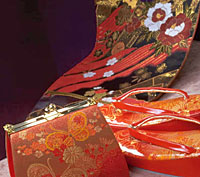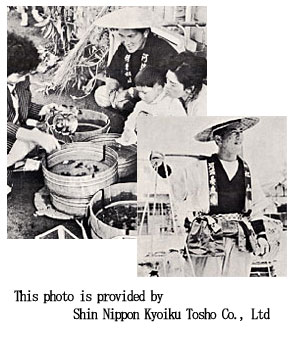|

 Koi (Magoi)” which is the ancestor of “Nishikigoi” is generally said to have originated in Persia in Central Asia. However, Koi fossils have been excavated from stratums of roughly 25 million to 5 million years old in Japan, which means that Koi may have naturally existed in Japan as well. Koi (Magoi)” which is the ancestor of “Nishikigoi” is generally said to have originated in Persia in Central Asia. However, Koi fossils have been excavated from stratums of roughly 25 million to 5 million years old in Japan, which means that Koi may have naturally existed in Japan as well.
”Chronicles of Japan”, a history book completed in 720, states that the Keikou Emperor (71~) kept Koi in his ponds.
That is to say, in Japan Koi raising dates back more than 1900 years.
From Magoi to Nishikigoi
The actual “Nishikigoi” is a mutated form of the edible Koi that was raised in former Yamakoshi Village (current Nagaoka-shi), Niigata, 200 years ago (1804-1830).
That is to say, the birthplace of Nishikigoi is Yamakoshi Village and Ojiya-shi, Niigata, Japan.
In this mountain-ringed region, the residents raked the mountains and built “rice terraces” to grow rice and vegetables. Above the “rice terraces” were preserve ponds to irrigate the terraces. Koi were raised in these ponds for a source of protein for winter, until one day, these Koi suddenly mutated, and Koi with different colors and patterns were swimming among the black Koi.
The farmers were amazed by this and made efforts to breed more beautiful and unique Koi.
This “mutated Koi” at first were a diversion only for people in this region, but soon they were bartered with goods from other regions and came to public attention. As a result, hobby-like improvements became the Koi farming business, and a broad range of varieties have been created up to the present date.
The origin of the name “Nishikigoi”
Nishikigoi were born approximately 200 years ago, but at the time they were called “Irogoi” “Hanagoi”, “Moyogoi, “and “Kawarigoi”.
 At a Koi show in Takesawa Village (a part of Yamakoshi Village), Mr. Kei Abe, Director of the Fisheries Agency of Niigata, saw the Taisho Sanshoku (Sanke) and was struck by their overwhelming beauty. His words were “this is a true Nishikigoi!”, and this is how Nishikigoi got its name. At a Koi show in Takesawa Village (a part of Yamakoshi Village), Mr. Kei Abe, Director of the Fisheries Agency of Niigata, saw the Taisho Sanshoku (Sanke) and was struck by their overwhelming beauty. His words were “this is a true Nishikigoi!”, and this is how Nishikigoi got its name.
”Nishiki” is a silk fabric woven with gold. The word “Nishiki” is used to describe beautiful and elegant things (for example, “Nishikie”=”Nishiki picture”), and Nishikigoi certainly is an elegant Koi which deserves that name.
Around 1940, the name “Nishikigoi” became the household word in Japan, and “NISHIKIGOI” is nowadays used worldwide.
|




